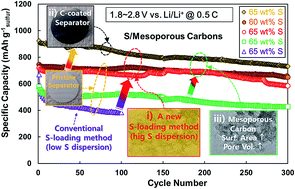Enhanced Li–S battery performance based on solution-impregnation-assisted sulfur/mesoporous carbon cathodes and a carbon-coated separator†
Abstract
The widespread use of lithium–sulfur (Li–S) batteries is still hindered by the low electrochemical activity of sulfur-species, and a short cycle life owing to anode instability coupled with polysulfide shuttle effects. As a first measure to counteract these issues, a new and simple sulfur-loading method consisting of solution impregnation and subsequent melt-diffusion (IM) is demonstrated and compared to the conventional method of physical mixing followed by melt-diffusion (PM). Using the IM method, sulfur is well encapsulated and highly dispersed in conducting mesoporous carbons (MCs) that possess an ideal pore diameter (around 10 nm) and a large pore volume (∼2.8 cm3 g−1). S/MC cathodes prepared by the IM method deliver much higher capacities, better rate responses and cycling stabilities up to 300 cycles (the fading rate was as low as −0.037% per cycle) with less concerns in lithium polysulfide (LPS) shuttling and impedance build up than S/MC cathodes prepared by the PM method. The S/MC cathodes prepared by the IM method has a pseudo-optimum sulfur content of 65 wt%, and when coupled with a new type of carbon-coated separator (CCS), a high areal capacity of >2.5 mA h cm−2 is successfully achieved, combined with excellent cycling stability and rate capability.



 Please wait while we load your content...
Please wait while we load your content...